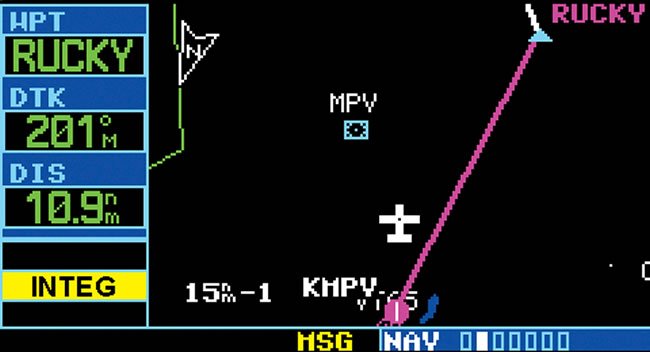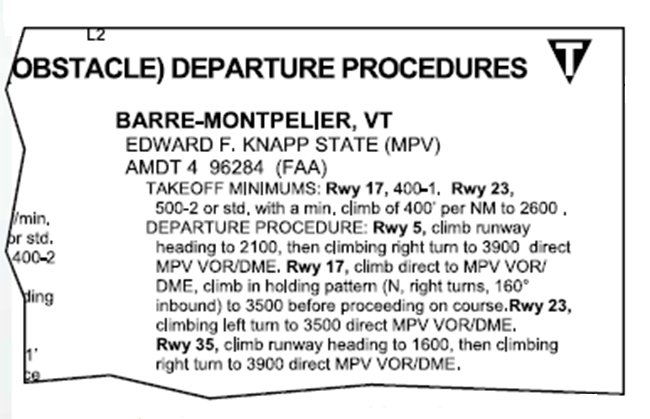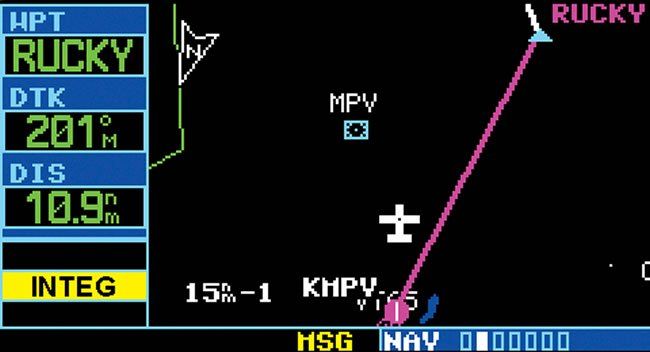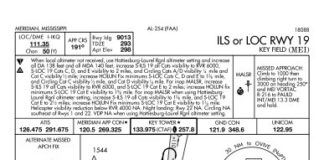Why is it when you’re trying to do something good, the weather always turns bad? Today’s mission is a Patient Airlift Services (PALS) flight from Montpelier, Vermont to Boston, Massachusetts. Your quick hop from your home base in Burlington, Vermont already gave you a decent instrument warm-up.
The ILS 17 into Montpellier was extra fun because you missed the NOTAM for the glideslope being out of service and the radio static made understanding Boston Center extra challenging. Seems like static in the clouds has been the norm since your bird came out of annual last month. Luckily, ceilings were about 1000 feet with good visibility beneath.
Now with your patients on board, it’s back into the clouds on departure from Runway 17. Your attempts to hail Boston as “Compassion 93J” are met with only bursts of static. Is your CDI dancing around more than usual, or is that just your imagination? Answers on page 23.
1. As always: Where are you?
a. Flying the ODP with CDI centered on the MPV VOR.
b. Flying your cleared route: KMPV RUCKY V141 LEB then as filed.
c. Transitioning from the ODP to your cleared route.
d. About to use a Cessna 172 for logging (by which we mean forestry).
2. Why do your VHF radio guidance and your GPS position disagree?
a. The GPS is incorrect; note the integrity flag.
b. The nav radio is incorrect for the same reason your comm is full of static.
c. Actually, they don’t disagree at all.
d. What do I look like, a radio technician? There’s no way to know.

3. The fix for the GPS integrity flag and radio static is most likely found:
a. At the alternator, where electrical noise is not getting suppressed.
b. In the radio stack, where there’s probably a bad connection.
c. On the fuselage, where something got disconnected during your annual.
d. In Trade-a-Plane, where you’re putting this bird on the block as soon as you get out of this mess.

4. All of the departure procedures tell you to go to the MPV VOR, but your clearance was “…RUCKY Victor 141 Lebanon (LEB) then as filed. Climb and maintain 4000. Expect 7000…” Given your current climb rate and likely distance to MPV, upon reaching it you should:
a. Fly the hold at MPV and await ATC instructions.
b. Fly to the first fix on your clearance.
c. Fly to the nearest fix on your clearance.
d. Since MPV isn’t on your route, you don’t need to comply with the departure procedure at all.
5. Given your issues with navigation and communication, you must:
a. Head for MPV and return to KMPV using the published approach.
b. Get safely on your filed route and fly to Boston lost comm.
c. Fly a non-IFR altitude and find VFR weather.
d. This is an emergency. You can do whatever you think is best.

6. Suppose you choose “b” in question 5, but you had planned to negotiate a lower altitude than 8000 because you were concerned about icing up there. Now you can’t do that. You should:
a. Fly the route at 8000 because that‘s what the rules say. Hope your 172 can carry the ice.
b. Fly the route at the highest altitude you can without picking up ice.
c. Fly the route at a VFR altitude (but still in IMC) that keeps you free of both ice and other aircraft (you hope).
d. …not have accepted the clearance knowing you didn’t want that altitude.
7. In still air, you expect your Cessna to be able to climb at 800 feet/min with an airspeed of 80 knots. What is the maximum climb gradient that you could achieve?
a. 200 feet/nm b. 400 feet/nm
c. 600 feet/nm d. 800 feet/nm
8. What is the minimum required climb rate to remain clear of obstacles when departing Runway 17?
a. 200 feet/nm b. 400 feet/nm
c. 500 feet/nm d. Unspecified
9. What’s the minimum required climb rate when departing Runway 23?
a. 200 feet/nm b. 400 feet/nm
c. 500 feet/nm d. None
10. True or False. Instrument departures are not authorized off of Runways 5 and 35.
11. True or False. The GPS INTEG flag means the position is incorrect.
12. When was this obstacle departure procedure last modified?
a. 1984
b. 1996
c. 2009
d. There’s no way to tell for departure procedures.
13. Knowing there is no other traffic and that your navs are mostly working, you exercise your emergency discretion and plan to land back at KMPV after the ODP. Crossing MPV and heading to TJAYS for the ILS or LOC Rwy 17, you must be at or above:
a. 3500, per the ODP
b. 5200, per the missed approach
c. 5900, per the approach procedure





